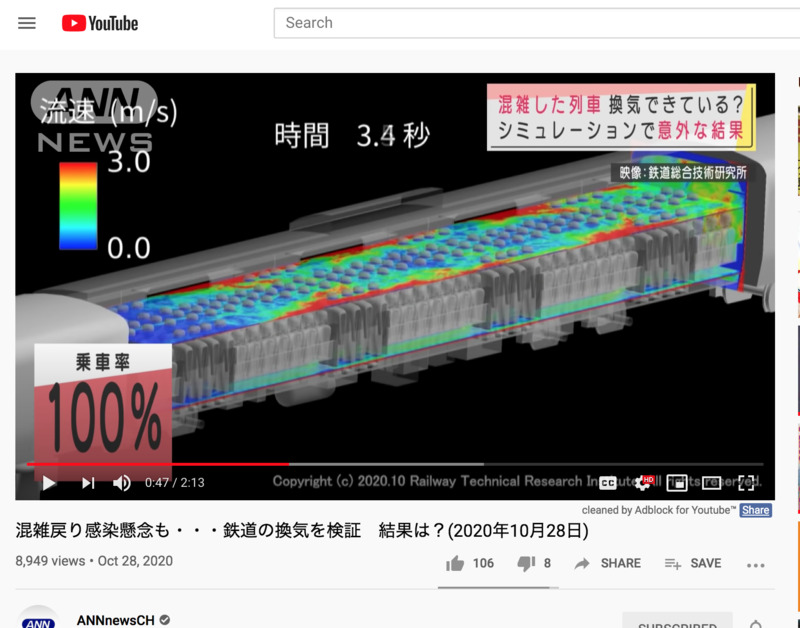Item
混雑戻り感染懸念も・・・鉄道の換気を検証 結果は?(2020年10月28日) - Concerns about returning to crowded situation ... Verifying railway ventilation What are the results? (October 28, 2020)
Title (Dublin Core)
混雑戻り感染懸念も・・・鉄道の換気を検証 結果は?(2020年10月28日) - Concerns about returning to crowded situation ... Verifying railway ventilation What are the results? (October 28, 2020)
Description (Dublin Core)
Japan is the country that uses public transportation a lot compared to the United States. I personally also commuted to school with train for more than 10 years and it is normal to use public transport to commute and to get anywhere rather than your own car. Parking on streets is very hard to find and all parking lots are very expensive, especially in downtown areas. It is also just more convenient to use public transport because Japan is one of the countries that trains/bus are never late and come on time. This news is really important because infection can easily happen in trains if it is not ventilated properly and people are not taking distances. However, Japan is very rigid on rules about time and a lot of workers have to get to work on certain time, which causes crowds on trains/bus at certain time.
最近、また列車が混んできたなと感じることが増えてきました。気になるのは車両の中の換気です。ある研究データが出てきました。 シミュレーションの結果は意外なものでした。一時はガラガラだった列車も、いつの間にかコロナ前の混雑が戻りつつあります。気になるのは感染リスクです。混み具合によって車内の空気の流れはどのように変化するのか・・・。 鉄道総合技術研究所は、この「換気」の問題に焦点を絞り、シミュレーションを実施しました。例えば乗客ゼロの状態と、乗客が増えて立っている人ですべてのつり革が埋まっている乗車率100%の状態を比べると、換気の効率にどのような違いが出るのか・・・。 条件は6カ所の窓を10センチ程度開け、時速70キロで走行した場合です。結果、乗車率ゼロでも乗車率100%でも換気効率に大きな違いは出ませんでした。 これは乗客が増えると、その分、車内の空気の体積が減るため。乗客がいないと5.3分に1回のペースで車内の空気が入れ替わりますが、乗車率100%だと4.5分。むしろ早まることが分かりました。ちなみに山手線の混み具合はコロナの影響が出る直前の2月初旬を「100」とした場合、5月に38%まで落ち込んだものの、その後、徐々に回復し、先月は65%まで戻しています。 今回のシミュレーションでは乗客が増えても空気の流れ自体にはさほど悪い影響がないことが分かりました。ただし、乗客が増えることによって不特定多数と接近してしまうなどのリスクは今回の計算には含まれていません。
Recently, I feel that the trains are getting crowded again. What is concerning is the ventilation inside the vehicle. Some research data came out.
The result of the simulation was surprising. The train, which was once rattled, is returning to congestion in front of Corona. What is concerning is the risk of infection. How does the air flow inside the car change depending on how crowded it is?
The Railway Technical Research Institute focused on this "ventilation" problem and conducted a simulation. For example, if you compare the state of zero passengers with the state of 100% occupancy rate where all the holding straps are filled with people standing with more passengers, what kind of difference will there be in ventilation efficiency?
The condition is when 6 windows are opened about 10 cm and the vehicle travels at 70 km / h. As a result, there was no big difference in ventilation efficiency between zero occupancy rate and 100% occupancy rate.
This is because the volume of air inside the car decreases as the number of passengers increases. If there are no passengers, the air inside the car changes at a pace of once every 5.3 minutes, but if the occupancy rate is 100%, it takes 4.5 minutes. It turned out to be rather quick. By the way, if the congestion level of the Yamanote Line is set to "100" in early February just before the influence of the corona, it dropped to 38% in May, but then gradually recovered and returned to 65% last month. ..
In this simulation, it was found that even if the number of passengers increased, the air flow itself was not so badly affected. However, the risk of approaching an unspecified number of passengers due to an increase in passengers is not included in this calculation.
最近、また列車が混んできたなと感じることが増えてきました。気になるのは車両の中の換気です。ある研究データが出てきました。 シミュレーションの結果は意外なものでした。一時はガラガラだった列車も、いつの間にかコロナ前の混雑が戻りつつあります。気になるのは感染リスクです。混み具合によって車内の空気の流れはどのように変化するのか・・・。 鉄道総合技術研究所は、この「換気」の問題に焦点を絞り、シミュレーションを実施しました。例えば乗客ゼロの状態と、乗客が増えて立っている人ですべてのつり革が埋まっている乗車率100%の状態を比べると、換気の効率にどのような違いが出るのか・・・。 条件は6カ所の窓を10センチ程度開け、時速70キロで走行した場合です。結果、乗車率ゼロでも乗車率100%でも換気効率に大きな違いは出ませんでした。 これは乗客が増えると、その分、車内の空気の体積が減るため。乗客がいないと5.3分に1回のペースで車内の空気が入れ替わりますが、乗車率100%だと4.5分。むしろ早まることが分かりました。ちなみに山手線の混み具合はコロナの影響が出る直前の2月初旬を「100」とした場合、5月に38%まで落ち込んだものの、その後、徐々に回復し、先月は65%まで戻しています。 今回のシミュレーションでは乗客が増えても空気の流れ自体にはさほど悪い影響がないことが分かりました。ただし、乗客が増えることによって不特定多数と接近してしまうなどのリスクは今回の計算には含まれていません。
Recently, I feel that the trains are getting crowded again. What is concerning is the ventilation inside the vehicle. Some research data came out.
The result of the simulation was surprising. The train, which was once rattled, is returning to congestion in front of Corona. What is concerning is the risk of infection. How does the air flow inside the car change depending on how crowded it is?
The Railway Technical Research Institute focused on this "ventilation" problem and conducted a simulation. For example, if you compare the state of zero passengers with the state of 100% occupancy rate where all the holding straps are filled with people standing with more passengers, what kind of difference will there be in ventilation efficiency?
The condition is when 6 windows are opened about 10 cm and the vehicle travels at 70 km / h. As a result, there was no big difference in ventilation efficiency between zero occupancy rate and 100% occupancy rate.
This is because the volume of air inside the car decreases as the number of passengers increases. If there are no passengers, the air inside the car changes at a pace of once every 5.3 minutes, but if the occupancy rate is 100%, it takes 4.5 minutes. It turned out to be rather quick. By the way, if the congestion level of the Yamanote Line is set to "100" in early February just before the influence of the corona, it dropped to 38% in May, but then gradually recovered and returned to 65% last month. ..
In this simulation, it was found that even if the number of passengers increased, the air flow itself was not so badly affected. However, the risk of approaching an unspecified number of passengers due to an increase in passengers is not included in this calculation.
Date (Dublin Core)
Creator (Dublin Core)
Contributor (Dublin Core)
Event Identifier (Dublin Core)
Partner (Dublin Core)
Type (Dublin Core)
Screenshot
Video
Link (Bibliographic Ontology)
Controlled Vocabulary (Dublin Core)
Curator's Tags (Omeka Classic)
Contributor's Tags (a true folksonomy) (Friend of a Friend)
Linked Data (Dublin Core)
Date Submitted (Dublin Core)
10/28/2020
Date Modified (Dublin Core)
02/24/2021
Date Created (Dublin Core)
10/28/2020
This item was submitted on October 28, 2020 by Youngbin Noh using the form “Share Your Story” on the site “A Journal of the Plague Year”: https://covid-19archive.org/s/archive
Click here to view the collected data.

